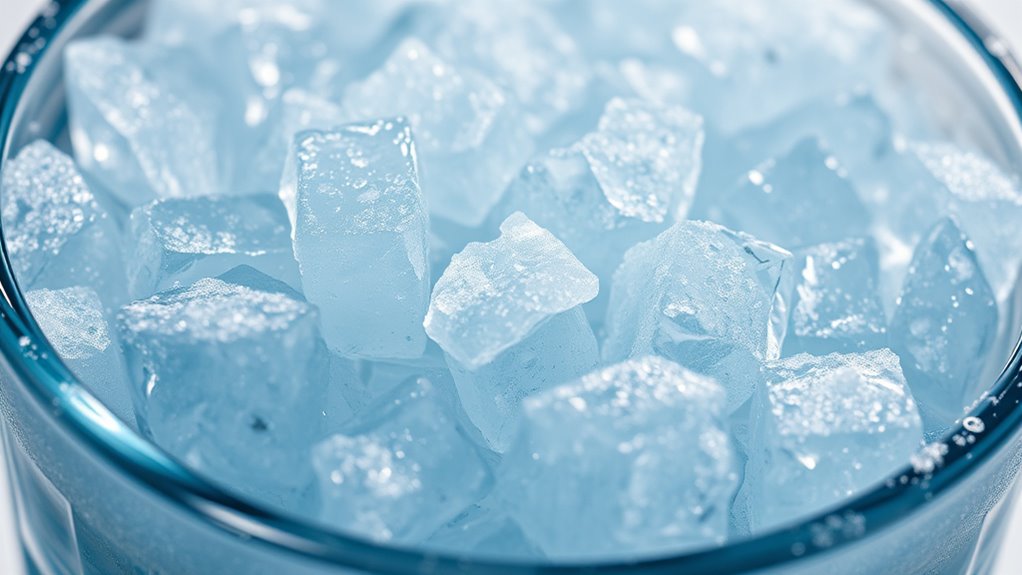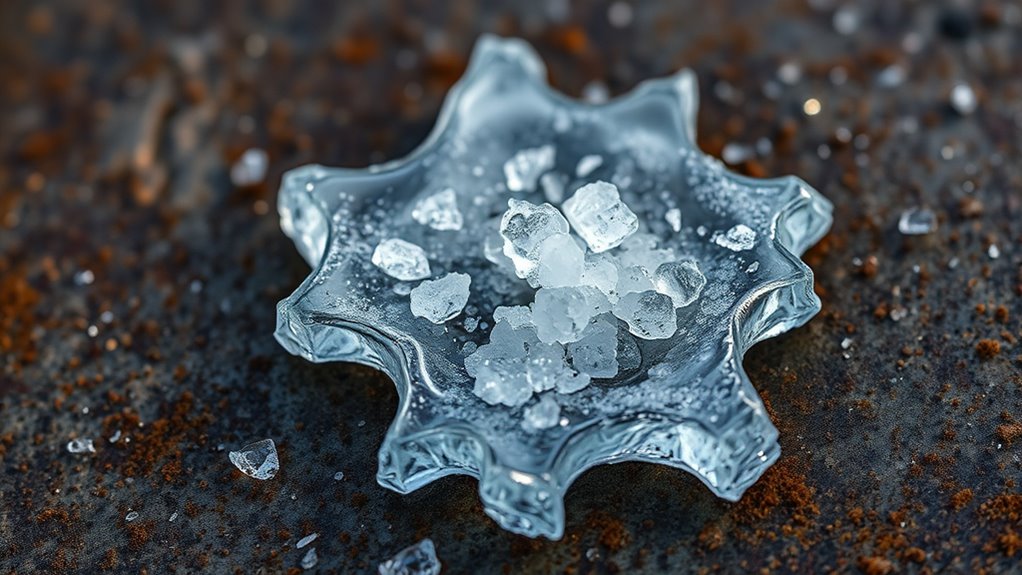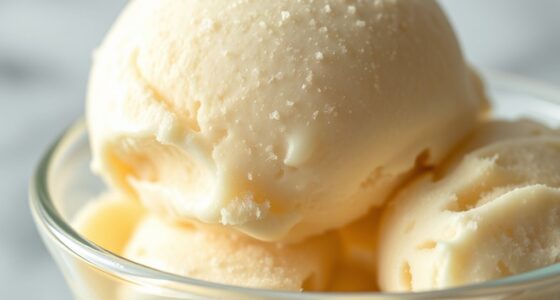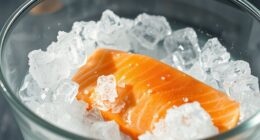You can learn how early humans used salt and ice to keep food fresh long before modern refrigeration. By mixing salt with ice, they created a colder environment through freezing point depression, slowing bacterial growth and preserving perishable items. This simple yet effective technique shows how chemistry can solve practical problems. If you continue exploring, you’ll uncover even more fascinating insights into how these ancient methods laid the groundwork for today’s food preservation.
Key Takeaways
- Early freezing techniques used salt and ice to lower temperatures through freezing point depression, enabling food preservation.
- Salt accelerates ice melting, creating a colder environment suitable for freezing perishable items.
- These methods extended food shelf life and prevented spoilage before modern refrigeration.
- Adjusting salt amounts allowed control over temperature, demonstrating practical chemical principles.
- This ancient practice showcases innovative use of chemistry to solve real-world food storage challenges.

Throughout history, people have harnessed simple yet effective methods to freeze and preserve food, and one of the most fascinating techniques involves using salt and ice. This method showcases early ingenuity in chemical preservation, where the combination of salt and ice creates a cooling environment that can slow down bacterial activity and extend the freshness of perishable items. By understanding how this process works, you gain insight into the fundamental principles of temperature control that made it possible to keep food safe over longer periods without modern refrigeration.
When you add salt to ice, it doesn’t just melt the ice faster; it actually lowers the melting point of water in a process called freezing point depression. This is essential because it allows the mixture to reach temperatures below 0°C (32°F), which is the normal freezing point of pure water. As a result, the salt-ice combination produces an environment that is colder than ice alone, creating a natural refrigeration system. You can see this principle in action when making homemade ice cream or preserving food during early times, where salt and ice were used in a makeshift cooler to maintain low temperatures. This technique provided a practical solution for food storage before the advent of modern refrigeration units.
The key to this method’s success lies in its ability to control temperature precisely. By adjusting the amount of salt added, you influence how cold the mixture becomes, giving you a degree of control over the preservation process. For example, more salt results in a lower temperature, which can be essential when trying to keep perishable goods from spoiling quickly. This understanding of chemical preservation through temperature control was revolutionary at the time, enabling communities to store surplus food for winter or long journeys without spoilage. Additionally, the temperature regulation achieved through this method underscores the importance of understanding chemical properties in practical applications.
Furthermore, this technique was not just about cooling; it also demonstrated how chemistry could be applied practically to solve everyday problems. The use of salt and ice allowed early humans and traders to extend the life of dairy, meats, and fish, which would otherwise perish rapidly in warm climates. You can appreciate that this simple yet effective method laid the groundwork for modern refrigeration, highlighting the importance of manipulating physical and chemical properties to achieve preservation.
In essence, the salt and ice technique exemplifies how an understanding of chemical preservation and temperature control can transform food storage. It’s a process rooted in fundamental scientific principles, yet it’s accessible enough that even today, it remains a powerful reminder of human ingenuity in food preservation.
Frequently Asked Questions
How Did Ancient Civilizations Discover Salt’s Freezing Point Depression?
You might not realize it, but ancient civilizations discovered salt’s freezing point depression through practical salting techniques and ice harvesting. By experimenting with adding salt to ice during food preservation or ice production, they observed that salt lowered the freezing point, making ice last longer. This hands-on approach helped them understand how salt influences freezing, laying the groundwork for modern refrigeration and cooling methods.
Were Early Freezing Techniques Used for Food Preservation or Other Purposes?
Frozen food fuss? Early freezing techniques primarily focused on food preservation, utilizing salt preservation and ice harvesting to keep perishables fresh. You might be surprised to learn that ancient civilizations used ice and salt to slow spoilage, extending the edible life of meats, fruits, and dairy. These methods showcased ingenuity, turning simple substances into sophisticated systems for safeguarding sustenance and supporting survival through seasonal shifts.
How Does Salt Impact the Freezing Point of Water Scientifically?
Salt effects the freezing point of water by lowering it, a process known as freezing point depression. When you add salt, it dissolves into the water, disrupting the formation of ice crystals and making it harder for water molecules to freeze. This means the freezing point drops below 0°C, allowing you to keep things colder longer or create a superchilled mixture for ice cream or cooling.
What Are Modern Applications of Salt and Ice in Industry Today?
You use salt and ice today in industries like brine chilling, where you lower temperatures quickly for food preservation or cold storage. You also control ice nucleation processes in snowmaking or freeze-drying, ensuring uniform freezing. Salt’s ability to depress the freezing point helps you manage temperature regulation efficiently, making these techniques essential in modern manufacturing, food processing, and climate control systems.
Did Early Cultures Develop Unique Freezing Methods Using Local Resources?
Did early cultures develop unique freezing methods using local resources? Absolutely, you do. They relied on traditional practices for cultural preservation, utilizing natural materials like snow, ice, or clay to cool and store foods. These methods varied by region, reflecting local climates and resources. Their ingenuity kept food fresh and preserved traditions, demonstrating how early societies adapted their environment creatively. Isn’t it fascinating how resourcefulness shaped cultural practices?
Conclusion
As you reflect on these early freezing techniques, remember how pioneers gently pushed boundaries with humble tools. Their quiet ingenuity reminds us that innovation often blooms from simple, delicate steps. Embrace the subtle lessons of patience and perseverance, knowing that even in small acts, there’s a quiet strength. Sometimes, the most meaningful progress comes softly, like a gentle frost—reminding us that growth often blooms in the most tender moments.









